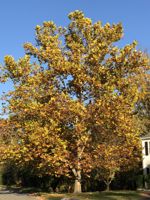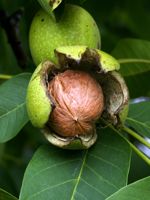Mon-Fri 9am - 5pm Mountain time
American Sycamore vs Carpathian English Walnut
Platanus occidentalis
Juglans regia Carpathian
NOT AVAILABLE THIS SEASON - MIGHT RETURN
NOT AVAILABLE THIS SEASON - MIGHT RETURN
American Sycamore is the largest tree native to eastern North America. Generally too large and messy to be a street tree, American Sycamore thrives in large, open spaces, such as an acreage or farm.
The bark is one of the main features that draw people to this tree. The outer bark flakes off in irregular pieces to reveal an attractive white, green, and cream colored inner layer, providing winter interest.
American Sycamore has an extremely fast growth rate, gaining up to 6 ft in one year, and will easily reach its mature height in a short period of time. Be wary of this trees' root system, as it's typically very extensive and needs lots of room to expand.
Carpathian English Walnut is a great shade tree or a fantastic addition to a food garden. The taste is described as having a full flavour with a hint of sweetness and butterscotch. They are great for fresh eating, cooking, and baking. Thin shelled nuts split right down the center, making them easy to crack. Harvest ranges from late September to early October.
It is known for being highly productive and more cold hardy than other English Walnut varieties.
Carpathian English Walnut is considered to be self pollinating but planting with a second variety will result in greater yields. It can be cross pollinated with Black Walnut and others.

